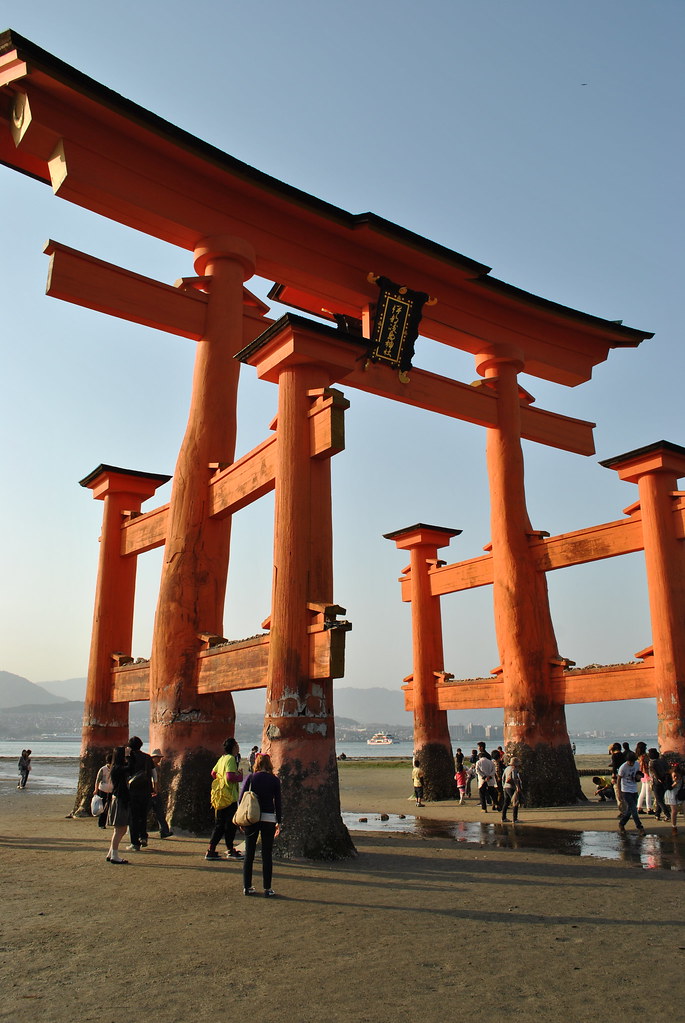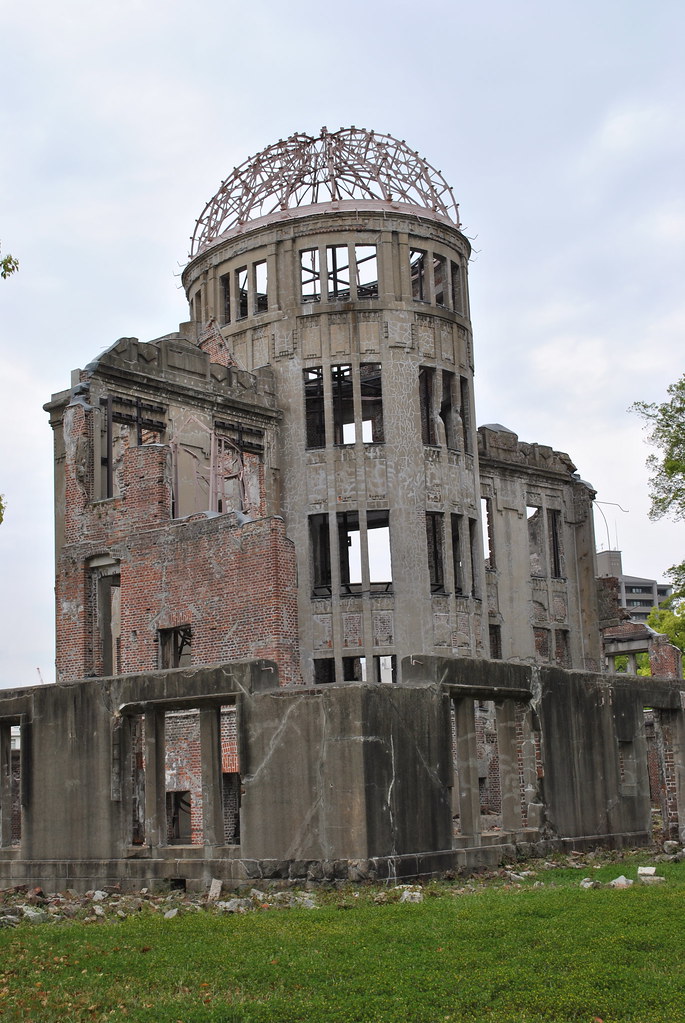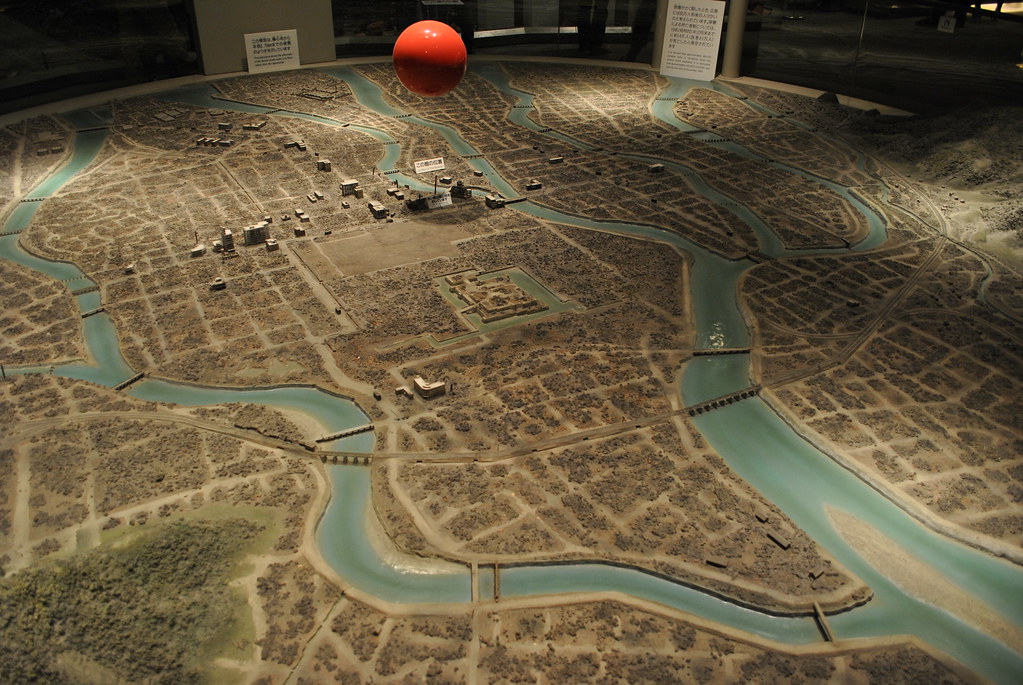Contrary to what you might have imagined, 広島 feels very much like a big city, with boutique shopping, gourmet restaurants and plenty of nightlife. Perhaps the most striking feature when you first arrive will be the tram system, which has been maintained since well before the war in preference to a 地下鉄 (ちかてつ - chikatetsu - subway). Buying spare cars from all over the world has given 広島 a mish-mash of every kind of streetcar, from old bone-shakers that rattle up and down the main streets to brand new express trams that glide noiselessly along purpose-built rails. These connect nearly every part of 広島, making it quick and easy for tourists and locals to wander the shopping districts, see the sights and find a nice spot to eat.
The first thing you will likely want to try is what's known as 広島焼 (ひろしまやき - Hiroshima-yaki), which is the 広島 take on お好み焼き (おこのみやき - okonomiyaki). Rather than the batter being beaten up with the キャベツ (kyabetsu - cabbage) into one thick "pancake", 広島焼 is constructed more like a sandwich; essentially it's a big pile of キャベツ cooked on a 鉄板 (てっぱん - teppan - hotplate) between two thin "discs" of batter. When it's first put on the 鉄板 it looks impractically huge, but the キャベツ cooks quite quickly with the rising heat and before long it flattens down into a much more manageable size. 広島焼 can be a small treat eaten while out and about or a full meal, particularly if you have one with extra filling like the 焼きそば (やきそば - yakisoba - fried noodles) above. Taste-wise, there's not much to separate 広島焼 and お好み焼き, but best not let the big fans of either hear you say that.
As far as shopping and sightseeing goes, a small island called 宮島 (みやじま - Miyajima - literally "Shrine Island") is a must-visit. It sits to the southwest of the city centre, a 20 minute ferry ride from the port. Alive with self-entitled 鹿 (しか - shika - deer) and lined with 商店街 (しょうてんがい - shoutengai - covered shopping streets) selling endless snacks and おみやげ (omiyage - souvenirs), it feels very much like 奈良 (なら - Nara) in miniature.
Some of the more famous おみやげ 宮島 offers are しゃもじ (shamoji - rice scoops) of all things. They range from tiny ones looped on to phone straps and keyrings up to more functional sizes carved out of fine wood. The island's largest - 7.7 metres in length and weighing in at 2.5 tonnes - is not for sale; you'd never get it into your suitcase anyway. If you have a sweet tooth, dozens of shops also sell my favourite 広島 おみやげ - もみじまんじゅう (momiji manjuu). These are sweet steamed buns in the shape of maple leaves containing あんこ (anko - bean paste), カスタード (kasutaado - custard), チョコレート (chokoreeto - chocolate), クリームチーズ (kuriimu chiizu - cream cheese) or other goodies. It's worth buying armfuls of these because half of them will be eaten before you manage to get them home as presents.
宮島 is so named because of 厳島神社 (いつくしまじんじゃ - Itsukushima Shrine), a World Heritage listed site that has cemented the island's reputation as one of the top three most scenic spots in Japan. 厳島神社 was remodelled in 1168 - which should give you some idea of its age - and now sprawls out hugely across the sandy shore with stages, halls and smaller shrines. These structures are connected by 300 metres of open-air corridors and all the woodwork is coated in vermillion lacquer which is said to keep away both evil spirits and corrosion. The most striking thing about 厳島神社, however, is how happy it is to get its feet wet.
This phenomenon is best illustrated by the 鳥居 (とりい - torii - shrine gate) right on the waterline, a colossal structure standing 16.6 metres high and weighing about 60 tonnes. Its main pillars have a circumference of almost 10 metres and even though its feet are wracked with barnacles, the 鳥居 stands happily under its own weight. At low tide, people are able to walk right out underneath, placing coins on the pillars for luck while hermit crabs watch on in confusion from the muddy ground.
At high tide, the sea rushes back in to reclaim the land and 厳島神社 earns its nickname - "the floating shrine". While these times aren't as good for exploring the area on foot, both the 鳥居 and the shrine itself are particularly beautiful when submerged, with their reflections stretching long in the lapping waves. The 鳥居 is well lit and visible most of the way across the bay; it's quite hard to look at anything else as you make the ferry trip back into the city centre.
The rest of 広島 is almost as pleasant and carefree as 宮島, so you might find yourself forgetting the obvious until you inevitably stumble on one of the tram stops - the "Peace Memorial Park". This is a large public space just to the southwest of where the 原爆 exploded, containing a museum and dozens of monuments and memorials to the victims. The most instantly recognisable of these is known as the "原爆ドーム" (genbaku doomu - "Atomic Bomb Dome"), the skeleton of what used to be the 広島 Commercial Exhibition Hall. At 8:15am on August 6th 1945, the 原爆 "Little Boy" exploded about 600 metres above and 160 metres southeast of the 原爆ドーム, incinerating it instantly but leaving enough of the structure standing for it to still be recognisable. Public opinion remained divided for some time; some argued that it should be preserved as a memorial while others insisted it should be demolished for safety and respect to the victims. It was eventually listed as a World Heritage site and regular preservation projects ensure it's one of the only parts of 広島 that still shows signs of the damage.
Within the Park is the Peace Memorial Museum, a collection of displays and comparisons of the 広島 landscape before and after the bombing. Nearly every building within a 2 kilometre radius was completely destroyed and 140000 lives were claimed by the physical blast, heat rays and ensuing radiation. The objects on display are a testament to the devastation - iron shutters warped and buckled, glass bottles melted into slag and walls stained black from radioactive rain. Some of the displays and photographs are very confronting in how they illustrate the tragedy, but equal care is taken in examining the context and reasoning behind it. Parts of the museum also show the city's dedication to peace - one display, for example shows copies of the hundreds of letters written to state leaders by successive mayors of 広島 urging an end to 原爆 testing and proliferation since the war.
The most heartbreaking stories the Peace Memorial Park offers are those of the victims themselves, the most famous of whom is Sadako Sasaki. She was exposed to the 原爆 blast when she was two years old but suffered no apparent injury and grew up seemingly healthy. Ten years later, she contracted leukemia and was hospitalised, where she began to fold 折鶴 (おりづる - oritzuru - paper cranes) in the hope of recovery; it's said that if someone is able to fold one thousand 折鶴, their wish will be granted. Despite achieving the goal, her prayers went unanswered and she lost her battle after eight months. After Sadako's death, the "Children's Peace Monument" was built to honour her and all the children who lost their lives in the bombing. Glass booths surround it, stuffed with tens of thousands of 折鶴 in chains and dioramas regularly sent by school children from all over Japan to add their prayers to Sadako's. Nearby, the main Memorial Monument sits within view of the 原爆ドーム, containing a register of the deceased and an inscription set in the stone: Let all the souls here rest in peace, for we shall not repeat the evil.
Despite the pain of the past, 広島 has certainly earned its reputation as a symbol of recovery from devastation. One of the most enduring images for the city is that of the clock stopped at the moment the 原爆 exploded, but I don't feel it captures the spirit of 広島 very well - the city has moved on since then and no time has been wasted in restoring it to its former glory and beyond. You might see 広島 as a beacon of hope and testament to the human spirit, an important historical and cultural landmark or just a unique, bustling city with plenty to see and do; whatever you're looking for on your trip there, you won't be leaving empty handed.












No comments:
Post a Comment
If you have any questions or additions, I would love to hear from you. I may not know the answer, but I'll do my best to find out in any case! You can post anonymously if you like, but abusive/unintelligible/inappropriate comments will not be published.